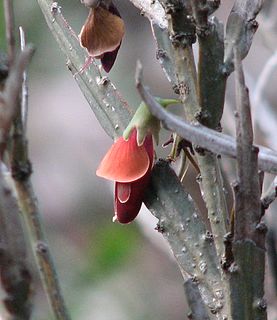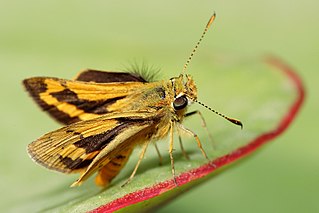
Frank Hann National Park is a national park in Western Australia, located 428 kilometres (266 mi) east-southeast of the capital, Perth in the Shire of Lake Grace. It was named for Frank Hann, an early explorer of the district. The park contains a wide array of flora, including seasonal wildflowers.

Acacia aneura, commonly known as mulga or true mulga, is a shrub or small tree native to arid outback areas of Australia. It is the dominant tree in the habitat that it gives its name to (mulga) that occurs across much of inland Australia. Specific regions have been designated the Western Australian mulga shrublands in Western Australia and Mulga Lands in Queensland.

Acacia pycnantha, most commonly known as the golden wattle, is a tree of the family Fabaceae native to southeastern Australia. It grows to a height of 8 m (26 ft) and has phyllodes instead of true leaves. Sickle-shaped, these are between 9 and 15 cm long, and 1–3.5 cm wide. The profuse fragrant, golden flowers appear in late winter and spring, followed by long seed pods. Plants are cross-pollinated by several species of honeyeater and thornbill, which visit nectaries on the phyllodes and brush against flowers, transferring pollen between them. An understorey plant in eucalyptus forest, it is found from southern New South Wales and the Australian Capital Territory, through Victoria and into southeastern South Australia.

Rosewood refers to any of a number of richly hued timbers, often brownish with darker veining, but found in many different hues.

Acacia cyclops, commonly known as coastal wattle, cyclops wattle, one-eyed wattle, red-eyed wattle, redwreath acacia, western coastal wattle, rooikrans, rooikans acacia, is a coastal shrub or small tree in the family Fabaceae. Native to Australia, it is distributed along the west coast of Western Australia as far north as Jurien Bay, and along the south coast into South Australia. The Noongar peoples of Western Australia know the plant as wilyawa or woolya wah.

Acacia saligna, commonly known by various names including coojong, golden wreath wattle, orange wattle, blue-leafed wattle, Western Australian golden wattle, and, in Africa, Port Jackson willow, is a small tree in the family Fabaceae. Native to Australia, it is widely distributed throughout the south west corner of Western Australia, extending north as far as the Murchison River, and east to Israelite Bay. The Noongar peoples know the tree as Cujong.

Acacia tetragonophylla, commonly known as curara, kurara or dead finish, is a tree in the family Fabaceae that is endemic to arid and semi-arid parts of central and western Australia.

Acacia, commonly known as the wattles or acacias, is a large genus of shrubs and trees in the subfamily Mimosoideae of the pea family Fabaceae. Initially, it comprised a group of plant species native to Africa and Australasia, but it has now been limited to contain only the Australasian species. The genus name is New Latin, borrowed from the Greek ἀκακία (akakia), a term used by Dioscorides for a preparation extracted from the leaves and fruit pods of Vachellia nilotica, the original type of the genus. In his Pinax (1623), Gaspard Bauhin mentioned the Greek ἀκακία from Dioscorides as the origin of the Latin name.

Acacia melanoxylon, commonly known as the Australian blackwood, is an Acacia species native in South eastern Australia. The species is also known as Blackwood, hickory, mudgerabah, Tasmanian blackwood, or blackwood acacia. The tree belongs to the Plurinerves section of Acacia and is one of the most wide ranging tree species in eastern Australia and is quite variable mostly in the size and shape of the phyllodes.
Teyl is a genus of spiders in the family Anamidae with four described species, all of which are endemic to Australia. It is one of the genera that was placed in the former tribe Teylini. The type species is T. luculentus.
Bruce Roger Maslin is an Australian botanist, known for his work on Acacia taxonomy.

The pygmy long-eared bat is a vespertilionid bat, found in the north of the Australian continent. An insectivorous flying hunter, they are one of the tiniest mammals in Australia, weighing only a few grams and one or two inches long.

Bossiaea walkeri, also known as cactus bossiaea or cactus pea, is a species of flowering plant in the pea family (Fabaceae). It is a leafless shrub that grows to between 0.5 and 2.5 metres high. Flowers are produced between July and November in the species' native range. It occurs in Western Australia, South Australia, Victoria and New South Wales. Bossiaea gets its name from the French physician, biologist, and botanist Joseph Hughes Boissieu Martiniere (1758-1788). Walkeri is named after Alex Walker, who first collected this type of specimen from the Peel Range in New South Wales.

Acacia myrtifolia, known colloquially as myrtle wattle, red stem wattle or red-stemmed wattle, is a species of Acacia native to coastal areas of southern and eastern Australia.

Ocybadistes walkeri, the greenish grass-dart, green grass-dart, southern dart or yellow-banded dart, is a type of butterfly known as a skipper found in eastern and southern Australia, with one subspecies found in the Northern Territory.

William Vincent Fitzgerald, was an Australian botanist. He described five genera and about 210 species of plants from Western Australia, including 33 Acacia and several Eucalyptus species. He also collected for other botanists such as Ferdinand von Mueller and Joseph Maiden and was known through his work on orchids. Eucalyptus fitzgeraldii was named for him by William Blakely.
Persoonia bowgada is a species of flowering plant in the family Proteaceae and is endemic to the south-west of Western Australia. It is an erect to spreading shrub with smooth bark, more or less cylindrical leaves and yellow flowers in groups of up to ten on the ends of branches.
Grevillea rara, also known as the rare grevillea, is a shrub of the genus Grevillea native to a small area in the South West region of Western Australia.

Lerista walkeri, also known commonly as the coastal Kimberley slider and Walker's lerista, is a species of skink, a lizard in the family Scincidae. The species is endemic to Australia.















